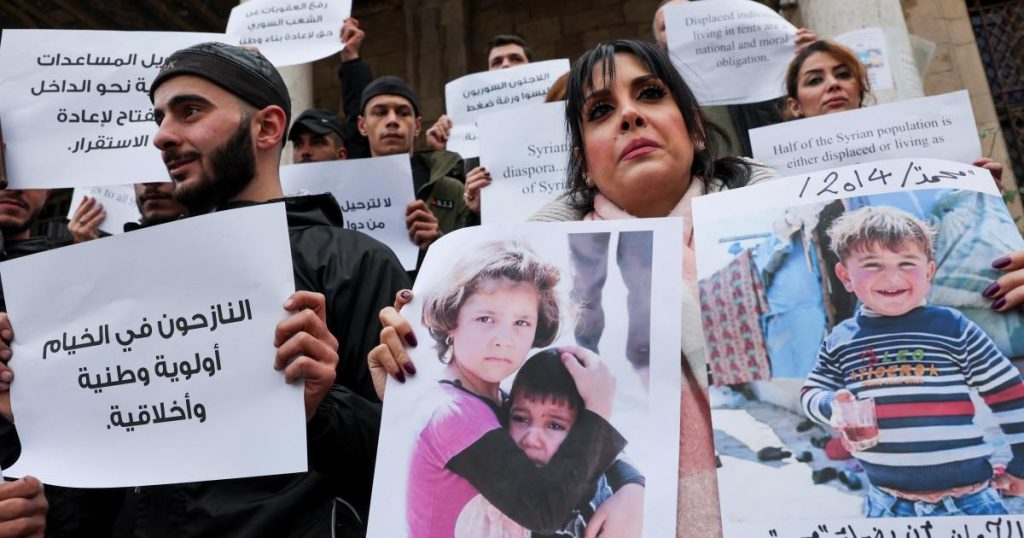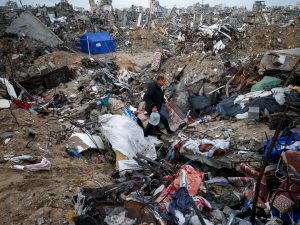The shocking defeat of Bashar al-Assad’s regime by rebel groups led by Hayat Tahrir al-Sham prompted a groundswell of domestic and international optimism. But already, Syria’s post-Assad future is on a knife’s edge. The obstacles to reconstructing the country are immense. Chief among them is the question of refugees forced from the country during Syria’s decadelong civil war. The return of these refugees could become the largest repatriation operation in decades, with over six million Syrian refugees abroad and seven million displaced within Syria. Hundreds of thousands of Syrians have already returned to their homeland, driven by their desire to check on the property they left, escape poverty and persecution in host countries, reunite with family, or take part in the next chapter of their country’s history.
Yet the country they are coming back to is profoundly different from the one they left. The destruction of homes and critical infrastructure, missing loved ones, widespread poverty, the risk of resurgent violence, and uncertainty about the country’s inexperienced new leaders—in addition to the protracted humanitarian crisis of the past decade—have made life unbearable for millions still in Syria. Hundreds of thousands more Syrians could return in the coming months. In doing so, they risk exacerbating an already dire situation. A mismanaged mass return will strain the already limited resources in the country, placing immense pressure on transitional Syrian authorities, UN agencies, and Syrian civil society to respond to the needs of the country’s citizens in a way that fosters stability and recovery.
Syria’s future depends on a historic undertaking: facilitating the return of Syrian refugees to their homes in a country mired in turmoil while meeting the needs of Syrians still there. The imperative now is to get the choreography right. Neighboring countries, international organizations, and the new Syrian transitional government should partner to create a refugee repatriation program capable of managing the return of Syrians, protecting the rights of vulnerable groups, resolving legal disputes over land, and reconstituting postwar Syrian society. At the same time, the transitional government and domestic and international nongovernmental organizations (NGOs) must work together, in spite of their mutual skepticism, to support the immediate and ongoing humanitarian needs of Syrians who never left the country. Focusing on the former without sufficient attention to the latter will create the conditions that could plunge the country back into crisis before it has had a chance to rebuild. This is a hopeful moment for Syria, but the real work of rebuilding the country is just beginning.
IN FLUX
The year 2024 saw a dramatic shift in the number of refugees returning to Syria. Since 2020, the number of Syrians returning annually typically remained below 51,000—less than one percent of the world’s 6.8 million Syrian refugees, which encompasses more than a quarter of Syria’s prewar population. By August 2024, an estimated 34,000 refugees had returned, but after Israel’s invasion of Lebanon in October 2024, an additional 350,000 fled from Lebanon back to Syria to escape the conflict. With another 125,000 returning since the fall of Assad in early December, the total number of returnees in 2024 reached nearly half a million. Already, another 125,000 have returned in 2025, according to UN figures. They could soon be joined by tens of thousands of Syrians forcibly deported by neighboring countries that may use Assad’s departure as a pretext to expel them.
Not all of those returns are permanent. Many Syrians returning do so to check on their land, assess security and economic conditions in the aftermath of the regime’s collapse, or reunite with family. For others, return is the only option to escape worsening conditions in host countries, where economic hardship, high living costs, and limited opportunities have made life increasingly untenable. If Syria stabilizes and economic conditions improve under its new government, the number of permanent returnees could grow substantially.
Syrian refugees in neighboring countries may face pressure to return prematurely (or even be deported outright) by neighboring countries, which are increasingly resistant to hosting large refugee populations while also balancing major economic deterioration, internal political pressure, and, in Lebanon’s case, a war of its own. Syrian refugees have experienced this backlash in the form of state repression, denial of legal residency and refugee status, and severe restrictions on rights and access to basic humanitarian services. Compounding the issue is the significant drop in international donor funding to host countries and refugee resettlement programs over the past five years, driven by donor fatigue and the post-COVID-19 global economic slowdown, which constrained global humanitarian aid budgets. The strain on governments already struggling to provide for their citizens has fueled growing calls from host communities for refugees to return home. Lebanon and Turkey have already been deporting Syrian refugees en masse since 2022, forcing them to return even as the civil war raged. Mass deportations could undermine the very stability host states have sought to achieve in Syria.
Meanwhile, inside Syria, most returnees will have nowhere to return to and limited resources with which to rebuild. Vast swathes of the country remain uninhabitable because of the wreckage of the war, with entire neighborhoods in major cities such as Aleppo, Damascus, and Raqqa still lying in ruins and villages flattened. The Syrian economy has contracted by over 80 percent since the war began in 2011. Widespread unemployment and rampant inflation have led to a poverty rate of 90 percent. The lack of basic infrastructure, clean water, electricity, health care, and schools complicates the possibility of mass reintegration. Many returnees have found their homes occupied by others or destroyed entirely, leading to disputes over housing, land, and property. With no established official mediating bodies, these unresolved grievances risk sparking tensions and further undermining the fragile stability that has emerged in the wake of Assad’s fall.
IT TAKES A VILLAGE
In Syria, as in any postconflict country, voluntary refugee return entails more than the physical return of refugees. It requires an overall improvement of the intertwined political, legal, and socioeconomic dimensions of return. Repatriation, while an immanent and continuous process, is often relegated to secondary status by state actors that prioritize state building, stabilization, early recovery, and reconstruction. As a result, returns can occur chaotically without any structure or organization, leaving returnees vulnerable and disconnected from broader recovery efforts targeting the existing population.
To avoid falling into this trap, Syria needs a cohesive repatriation plan early to ensure that returnees are integrated into the long-term development of the country and do not undermine its recovery process. The Syrian transitional government can create a cooperation framework by engaging with the UN Refugee Agency (UNHCR), the body’s lead agency for managing refugee returns, and neighboring countries, including Jordan, Lebanon, and Turkey, to effectively manage ongoing returns and ensure regional stakeholders fulfill their commitments to prevent forced returns. Host countries should promise not to push refugees to return; permit the UNHCR to lead a gradual, organized voluntary return process; and allow Syrians who choose to temporarily return to Syria on “go and see visits” to evaluate conditions the right to come back. The UNHCR and the international community should incentivize states to uphold these commitment by tying humanitarian and development aid to compliance. The EU’s 2024 Lebanon development aid package and the $1.2 billion in humanitarian and development aid that Jordan receives from the United States annually could be used as particularly valuable leverage.
Nontraditional donors, especially Arab Gulf states, could also be tapped to provide additional resources to incentivize host states to comply. The repatriation framework could later be expanded to include the EU and other refugee-hosting countries outside of the Middle East so that voluntary returns from Europe can be sustainably managed with the UNHCR once economic and security conditions in Syria have improved. If Syria slips back into conflict, premature or coerced returns would only trigger new displacement of returnees, who may again flee to neighboring countries for safety. Establishing a clear and coordinated approach will help avoid a dangerous push for mass return before the country is prepared.
Syria’s caretaker government will be responsible for managing large-scale returns, but it needs to strengthen its institutional capacity to do so effectively. Rebuilding state institutions is crucial for resuming the delivery of public services, rebuilding infrastructure, and restoring essential civil services, though reconstructing a public sector that can handle these tasks will take time. The provisional government will also be responsible for addressing challenges returnees will face, including ensuring their protection; supporting their reintegration into local communities; restoring their housing, land, and property rights; and building new housing and communities for Syrians who return home to find the lives they left behind obliterated by the war. The government will need to systematize civil documentation; establish transparent legal mechanisms to resolve disputes over land and property; and provide protection and support for vulnerable groups, including minorities, women and children, and the disabled. It will also need to provide housing and financial assistance for Syrians displaced as returnees reclaim their property, and to resolve the tensions that might result from those reclamations.
The government cannot and should not undertake this massive effort alone. The UNHCR will be better positioned to facilitate voluntary refugee return once conditions in Syria improve, but the agency must begin scaling its monitoring of refugee intentions, documenting return flows, and ensuring returnees have access to services in their areas of return. The agency can support and advise the caretaker government’s efforts to draft and amend national laws that align with international legal protections for displaced people. It can also support the government’s efforts to improve the issuance of civil documentation for displaced Syrians in and outside of Syria, as it has during the Iraq and Afghanistan refugee crises.
HOMEMAKING SERVICES
Managing repatriation will depend on the Syrian transitional government achieving a basic level of stability and a local capacity to address the myriad of humanitarian challenges already present. The potential for renewed conflict is high, and internal displacement has continued since Assad fell, as a result of ongoing clashes between Turkish-aligned groups and the U.S.-backed and Kurdish-dominated Syrian Democratic Forces in northeast Syria. A potential U.S. withdrawal from Syria could exacerbate these challenges. And the Trump administration’s freeze on U.S. foreign aid and gutting of USAID puts in jeopardy humanitarian and development programming across the country, including funding for the UNHCR, precisely at a moment in which millions of Syrians continue to depend on humanitarian aid. Maintaining and strengthening Syria’s humanitarian response, in part by expanding the role of civil society groups currently leading it, is crucial for improving the conditions on the ground and making the eventual wide-scale return of Syrians possible.
Humanitarian actors learned from the Syrian conflict that maintaining access to all of Syria during times of crisis requires keeping open routes from neighboring countries. If conflict resumes, UN agencies and humanitarian actors can continue reaching those in need across borders. The “Whole of Syria” framework, established by the UN Security Council, has proved to be the most effective model for delivering aid to Syria. The model, which uses a constellation of UN offices in neighboring Jordan and Turkey to coordinate cross-border aid deliveries and monitor conditions from both inside and outside Syria, should be kept in place. Key UN agency hubs in Amman, Jordan and Gaziantep, Turkey, which possess the infrastructure and capacity to facilitate large-scale cross-border operations, must remain open and continue to deliver aid into Syria and carry out monitoring missions, particularly in areas where humanitarian needs are most acute and where large numbers of returnees are likely to resettle so they can support reintegration efforts.
Syrian-led NGOs should also take on an expanded role in both immediate humanitarian needs and long-term recovery efforts. These groups have been the backbone of the country’s humanitarian response throughout the war. They possess deep local knowledge; established networks that can facilitate immediate relief, reintegration, and rebuilding efforts; and operational flexibility, allowing them to work effectively in areas where state capacity is absent. Civil society organizations also serve as neutral actors capable of providing a bridge between Syrians and the interim authorities, especially in communities wary of the government or at risk of sectarian tensions. Local communities are more likely to trust and accept these organizations, mitigating the potential for local-level conflict to break out as a result of mistrust or misperception. To maximize their reach and effectiveness, the caretaker government must establish clear legal and policy guidelines that direct NGO activity toward filling critical service gaps, and it must ensure that these groups can be held accountable. During the war, NGOs served as the de facto public-sector leaders in the absence of the state. As the new government matures, NGOs should transition management of a revitalized public sector to the state, while continuing to provide support and services to their communities. Joint committees composed of local authorities, NGOs, and the private sector can ensure that recovery efforts are inclusive and responsive to community-specific needs.
The international community views Syrian civil society organizations more favorably than the caretaker government, whose leaders were classified as terrorists in many countries until recently. Although the U.S. Treasury Department’s General License 24, which authorizes a range of transactions in Syria to facilitate the flow of humanitarian aid and services, provides some sanctions carveouts for the Syrian state, NGOs are a vetted channel for international donors to continue funding the aid response in Syria while broader sanctions remain in place. But the world should not look to NGOs to permanently replace the role of the government, whatever ideological disagreements leaders might have with Hayat Tahrir al-Sham and other armed factions. For the recovery to proceed sustainably, the government must be seen as legitimate and capable of managing reconstruction.
POINT OF RETURN
Failure to coordinate the return of Syrian refugees will have severe consequences for Syria, neighboring host countries, and Syrian refugees themselves. Syria’s stability hinges on a sustainable national recovery, and a flood of returnees could overwhelm the fledgling government, undermining the state’s fragile stability. Host states could also suffer if chaotic returns provoke another crisis in Syria, which would push thousands of new refugees back to their borders seeking entry. For Syrian refugees, an uncoordinated or premature return could mean again enduring extreme poverty, the risk of further displacement, or even death, just as the situation looked to be improving.
Conversely, an organized return and reintegration process could allow Syria to achieve lasting economic and political stability without overburdening the state’s institutions, Syrian civil society, or aid agencies. Return processes are often messy, but as successes in Iraq and Afghanistan show, coordinating repatriation can enhance the protection of displaced communities and reduce the likelihood for further displacement upon return. The 2003 tripartite agreement among the governments of Afghanistan and Pakistan and the UNHCR created a long-term framework for protecting the rights of refugee returnees and monitoring and facilitating voluntary repatriation. In Iraq, ongoing government cooperation with the UNHCR has helped provide protection and support for millions of internally and externally displaced Iraqis who later returned home amidst internal conflict. The lesson for Syria is that integrating countries of origin, host states, and the UNHCR in the recovery effort will not fully remove the risks and burdens of repatriation for refugees, but is the most effective way to manage the many complications that may arise.
Syria’s future hinges on the safe, dignified return of the refugees who will help rebuild a nation scarred by years of conflict. Syrians, in cooperation with the UN and the international community, must seize this moment to lay the groundwork for lasting peace. If they do not, Syria risks descending into deeper instability, leaving millions of returnees stranded in a country unable to support them. The window of opportunity is closing, and the cost of inaction will haunt Syrians for generations.
Loading…









